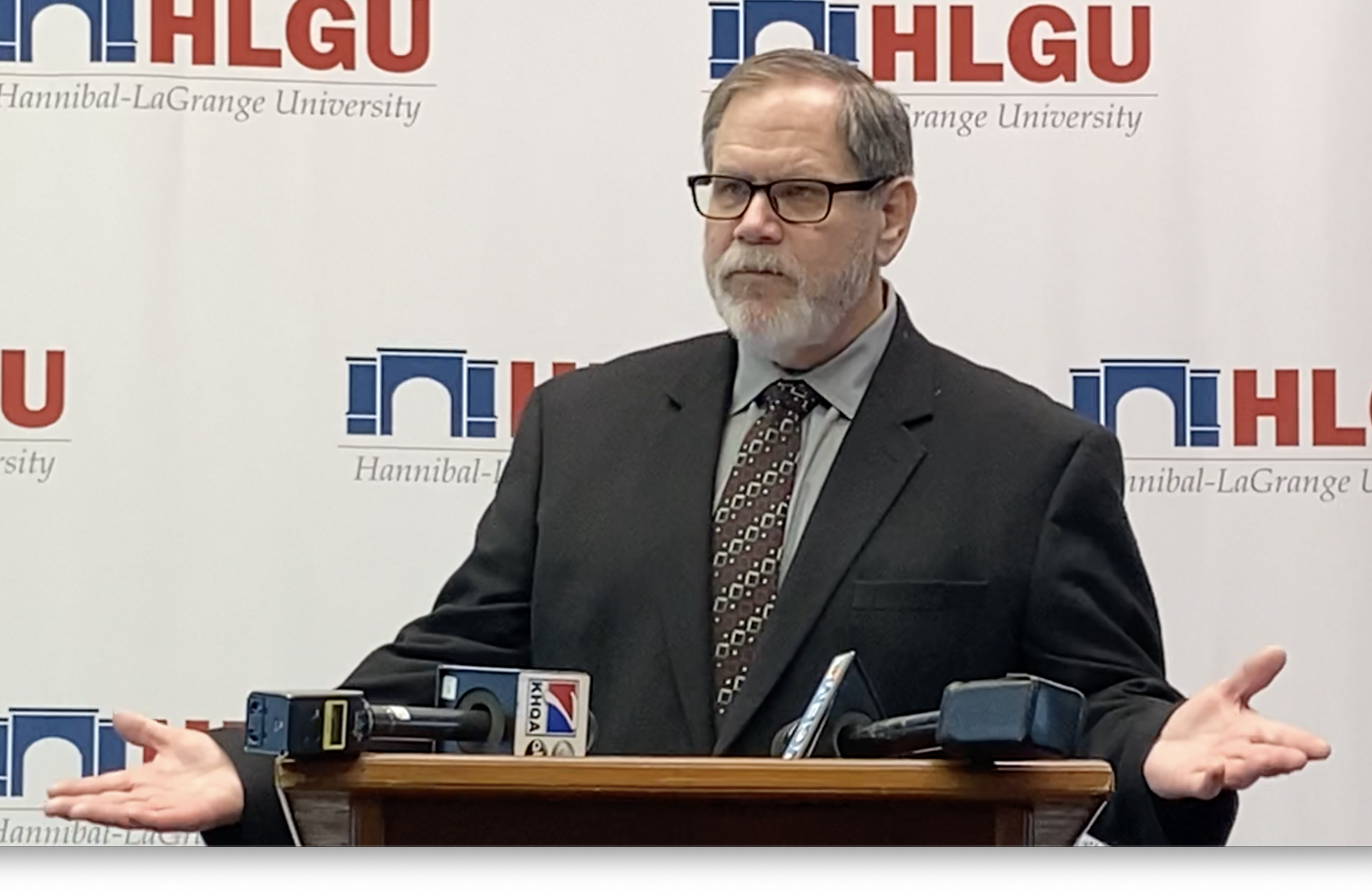‘The first taste of a bitter cup’: Financial collapse averted at Hannibal-LaGrange University, but at what cost?

This story first appeared on the Inside Higher Ed website on May 26, 2022. It is reprinted here in its entirety, with permission.
On the morning of May 2, the leaders of Hannibal-LaGrange University called faculty and staff into a meeting to share good news: they had raised $1.5 million and would remain open for the fall semester.
Employees had been waiting anxiously for such news since March, when the nearly 100-year-old Baptist college in Missouri received a dire financial assessment. Though the funds raised fell short of the $2.2 million administrators said they needed to pay off the university’s debts, they appeared to be enough to avert the “imminent disaster” transitional president Rodney Harrison said the institution was facing two months earlier.
Ray Carty, Hannibal-LaGrange’s vice president for institutional advancement, called the fundraising success a sign of God’s blessing.
“People are responding to the work that God has yet to do at HLGU,” he told The Pathway, the official news arm of the Missouri Baptist Convention, which also owns Hannibal-LaGrange.
A few hours after the meeting, administrators began calling individual faculty and staff into Harrison’s office for the bad news: they needed to let people go to help fulfill an additional $1.1 million in cost-saving austerity measures.
The layoffs included multiple department chairs, a sitting Missouri state representative and a two-time Fulbright scholar who was the sole faculty member in the history department, according to the university’s employee directory. Many of those let go had been at Hannibal-LaGrange for well over a decade.
Christina Brennemann, chair of HLGU’s communications studies department, and her husband, Kyle Brennemann, the university’s public safety director, were let go in back-to-back meetings. Christina, who had just finished her 18th year there, said that while she expected the university to make cuts, she was thrown by the disconnect between the “good news” officials delivered early in the day and the wave of layoffs that came later that afternoon.
“The timing made it hard to stomach,” she said. “These are tough days for our family.”
As the week went on, so did the layoffs. Louis Riggs had taught at Hannibal-LaGrange for 17 years before he was let go earlier this month. His wife, Anne Riggs, had worked at the institution for 18 years, most recently as director of the nursing program; she, too, was laid off.
Louis Riggs, an English professor who is also a Missouri state representative, said senior faculty members were most affected by the layoffs. He expressed worry that their removal will have serious consequences for the university’s institutional memory as well as the education it delivers.
“The quality of the education is going to be much different,” he said. “We’re talking about hundreds of years of experience walking out the door … I don’t know how you replace that.”
These are not the first cuts the university has made since its exigency announcement in March. Administrators promptly put all faculty members on temporary contracts and discontinued retirement benefits. Payroll was also cut by 20 percent through reduced workweeks, furloughs and individual pay cuts. The wrestling and golf programs were dropped last month.
In an email to Inside Higher Ed, Harrison and Vice President Robert Matz declined to give the exact number of faculty who were laid off, but they said that 15 percent of “faculty positions” had been eliminated or reduced to part-time roles, and some of the workforce reduction took place through retirements and resignations.
“While we grieved at the departures of these valued colleagues, there was not another option that carried HLGU into the future,” Harrison and Matz wrote.
Faculty sources contacted for this article said that at least a dozen professors and staff would not be returning in the fall.
Because their 12-month contracts were exchanged for nonbinding two-week contracts in March, faculty said they did not expect to be paid past the end of this month.
Harrison and Matz said that while all faculty contracts were canceled as a result of financial exigency, “the board and administration are committed to honoring what we hold to be a moral obligation to the impacted faculty and staff as revenue and giving allows.”
Tim Fuller, the founder of Fuller Higher Ed Solutions, a consulting firm for Christian colleges, said that when an institution appears to be headed for a cliff, the desire to stay open may conflict with the college’s educational mission.
“Christian colleges see their mission as going beyond just them, preparing these people for whatever it is God is calling on them to do,” he said. “It’s challenging when the mission becomes ‘We need to do whatever we need to do in order to stay open’ … You start thinking, we’ve lost a little bit of our way.”
‘A Very Unsure Future’
Harrison and Matz wrote that in addition to fundraising and workforce reduction, they undertook a “reworking of the institution’s entire business model to create a more sustainable path for the university’s future.” That includes a “streamlined curriculum” and expanded online offerings.
As of Wednesday, the vast majority of classes in HLGU’s course catalog for fall 2022 were marked “TBA” where the assigned professor would normally be listed. But despite the layoffs, Harrison and Matz wrote that they “do not anticipate” having to cut any courses and that faculty will be contracted for “the same number of credit hours” as this past semester.
Still, Louis Riggs fears that the exigency measures will have a lasting impact on enrollment numbers and said students are “looking at a very unsure future.”
“How do you expect to instill confidence … when you continue to cut and cut and cut, to the point where there’s basically nobody left, and at the same time advertise yourself as offering a world-class education?” he said. “Well, which world? Not the world most of us live in.”
In the past decade, Hannibal-LaGrange has seen its enrollment drop by 35 percent, from around 1,200 students in 2012–13 to 780 in 2021–22. It has also struggled with re-enrollment; in 2017, the retention rate hit a low of 50 percent, but it rose to 60 percent in 2020, according to the Integrated Postsecondary Education Data System.
For a small institution that is largely financially dependent on tuition, reversing that trend—or, at the very least, capping the losses—is crucial for the university’s future.
Harrison and Matz said that while fall enrollment won’t be finalized until the term starts, they are “pleased with the retention numbers.”
Christina Brennemann said the changes and instability have not gone unnoticed by the student body. She recalled numerous students telling her they “sensed real desperation” on campus after returning from spring break. Many of her advisees stopped by her office to share their anxieties and ask for advice, she said.
“If you want to keep morale and trust and help students return, you help them feel better about what they’re coming back to,” she said. “It’s the unknown and the uncertainty that’s probably the most frustrating for them.”
Fuller said that when there’s a public financial crisis and wide-ranging cuts like those at Hannibal-LaGrange, attracting new students—and retaining current ones—can be difficult.
“It’s already challenging enough to recruit students given everything else that’s going on,” Fuller said. “When there’s this sort of shot across the bow institutionally, that makes it even more so.”
A Hierarchical Culture
Christina Brennemann’s perspective on Hannibal-LaGrange’s financial and management challenges is not just one of a longtime faculty member: she wrote her Ph.D. dissertation on the marketing of small Midwestern Christian colleges, using HLGU as her case study.
For her research, she spoke with about 50 faculty members, administrators and staffers at the university, and she said the vast majority shared the same concerns: that stakeholders outside the administration had virtually no say on matters of enrollment, fiscal management or strategic planning.
“What came out in my findings was that there was this great distance between faculty and staff and administrative decisions,” she said. “It’s called a hierarchy culture, because that’s what it is. It’s strictly top-down.”
When she offered to share her findings with then president Anthony Allen and other officials in 2018, they listened attentively during the hourlong meeting—and then did nothing, she said.
“It was a great conversation,” she said. “And, as far as I know, that’s where it ended.”
Louis Riggs said that there was “no shared governance” at Hannibal-LaGrange, which he believes may have contributed to the university’s financial troubles and, ultimately, the need to lay off so many longtime faculty.
“Some of the warning signs I saw, I’m not going to say they were ignored, but they didn’t get a lot of attention,” he said. “Then the folks who got it in the neck — the faculty members, the well done, good and faithful servants — are victims of circumstances well beyond our control.”
‘The First Taste of a Bitter Cup’
After nearly two decades at Hannibal-LaGrange, Louis Riggs said he truly hopes the university is able to remain open past the fall semester. But given the severe cuts, declining enrollment and fast-approaching demographic cliff for prospective college-age students, he is not optimistic about the university’s future.
“I don’t think there’s an awareness that this is the first taste of a bitter cup,” he said.
Hannibal-LaGrange is not alone in facing a difficult future.
“Higher education in general, not just Christian higher education, was heading for a thinning of the herd before the pandemic,” Fuller said. “Coming out of the pandemic, without that federal [stimulus] money, those issues that were real before are more real now … and the pace of places facing what Hannibal-LaGrange is facing is going to pick up.”
Fuller said the choice between succumbing to years of declining enrollment trends and “hunkering down” through austerity measures is a difficult one, but one that more institutions like Hannibal-LaGrange may have to make in the coming years.
“It’s a choice between death by a thousand cuts and ripping the Band-Aid off all at once,” he said. “Neither is a particularly pleasant choice to have to make.”
Though concerned for his out-of-work colleagues, Louis Riggs said he isn’t worried about his financial future; he plans to go back into law and will still have his political career. But he will dearly miss teaching at Hannibal-LaGrange.
“I would have loved to have taught there until the end of my life,” he said. “The relationships you build with students, with colleagues, with folks in the community … it’s a heart-wrenching blow to think that’s gone.”
Miss Clipping Out Stories to Save for Later?
Click the Purchase Story button below to order a print of this story. We will print it for you on matte photo paper to keep forever.

